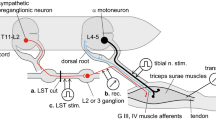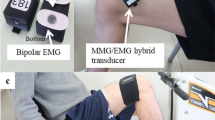Summary
A pathologically increased muscle tone is frequently observed. Objective methods for measuring directly the muscle-relaxant action of drugs in laboratory animals are scarce. This study shows that a computerized mechanomyographic method allows the assessment of myorelaxant drugs. The method consists of the successive bending and straightening of the rat's foot in the ankle joint and the separate measurement of resistance of extensors and flexors of the hind foot to passive movements. The two well-known antispastic drugs diazepam and baclofen reduced the normal muscle tone in both groups of muscles in non-treated animals as well as the muscle tone increased by reserpine (10 mg/kg i.p.). The results obtained show that the mechanomyographic method directly and reliably reveals the myorelaxant action of drugs.
Similar content being viewed by others
References
Andén N-E, Johnels B (1977) Effects of local application of apomorphine to the corpus striatum and to the nucleus accumbens on the reserpine-induced rigidity in rats. Brain Res 133: 386–389
Blum JE, Haefely W, Jalfre M, Polc P, Scharer K (1973) Pharmakologie and Toxikologie des Antiepileptikums Clonazepam. Arzneimittelforschung 23: 377–389
Dickinson SL, Longman DA, Slater P (1982) A method for measuring drug-induced changes in limb muscle tone in the rat. J Neurosci Methods 5: 195–200
Driessen JJ, Van Egmond L, Van der Pol F, Crul JF (1987) Effects of two benzodiazepines and a benzodiazepine antagonist on neuromuscular blockade in anaesthetized cat. Arch Int Pharmacodyn Ther 286: 58–70
Johnels B, Steg G, Ungerstedt U (1978) A method for mechanographical recording of muscle tone in the rat: the effect of some antiparkinsonian drugs on rigidity induced by reserpine. Brain Res 140: 177–181
Keane PE, Simiand J, Morre M, Biziere K (1988) Tetrazepam: a benzodiazepine which dissociates sedation from other benzodiazepine activities: I. Psychopharmacological profile in rodents. J Pharmacol Exp Ther 245: 692–698
Kolasiewicz W, Baran J, Wolfarth S (1987a) Mechanographic analysis of muscle rigidity after morphine and haloperidol: a new methodological approach. Naunyn-Schmiedeberg's Arch Pharmacol 335: 449–453
Kolasiewicz W, Cools A, Ossowska K, Wolfarth S (1987b) The neostriatal inhibition of catalepsy, but not of muscle rigidity, evoked from the substantia nigra pars reticulata. Pharmacol Biochem Behav 28: 453–457
Randall LO, Schallek W, Sternbach LH, Ning RY (1974) Chemistry and pharmacology of the 1,4-benzodiazepines. In: Gordon M (ed) Psychopharmacological agents, vol III. Academic Press, New York, pp 175–281
Rice GPA (1987) Pharmacotherapy of spasticity. Some theoretical and practical considerations. Can J Neurol Scie 14: 510–512
Stefański R, Plaźnik A, Paŀejko W, Kostowski W (1990) Myorelaxant effect of baclofen injected to the nucleus accumbens. J Neuronal Trans [Parkinson's Disease and Dementia] 2: 179–191
Turski L, Havemann U, Kuschinsky K (1983) Reversal of the muscle relaxant effect of diazepam by the specific benzodiazepine antagonist Ro 15–1788; an electromyographic study in morphine model of muscular rigidity in rats. Life Sci 33 [Suppl I]: 755–758
Turski WA, Schwarz M, Turski L, Sontag K-H (1984) A specific benzodiazepine antagonist CGS 8216 reverses the muscle relaxant effect of diazepam but not that of phenobarbitone. Eur J Pharmacol 98: 441–444
Author information
Authors and Affiliations
Additional information
Send offprint requests to S. Wolfarth at the above address
Rights and permissions
About this article
Cite this article
Wolfarth, S., Kolasiewicz, W., Ossowska, K. et al. Direct mechanomyographic measurement of the myorelaxant action of baclofen and diazepam in normal and reserpinized rats. Naunyn-Schmiedeberg's Arch Pharmacol 345, 209–212 (1992). https://doi.org/10.1007/BF00165738
Received:
Accepted:
Issue Date:
DOI: https://doi.org/10.1007/BF00165738




